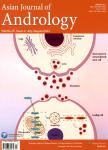Characterization of MAGEG2 with testis-specific expression in mice
Characterization of MAGEG2 with testis-specific expression in mice作者机构:School of Life Sciences Gwangju Institute of Science and Technology Gwangju 61005 South Korea.
出 版 物:《Asian Journal of Andrology》 (亚洲男性学杂志(英文版))
年 卷 期:2017年第19卷第6期
页 面:659-665页
核心收录:
学科分类:1002[医学-临床医学] 0905[农学-畜牧学] 09[农学] 0901[农学-作物学] 090501[农学-动物遗传育种与繁殖]
基 金:supported by the Mid-career Researcher Program through NRF grant funded by the MEST the Bio and Medical Technology Development Program of the National Research Foundation of Korea funded by the Ministry of Science, ICT and Future Planning Systems Biology Infrastructure Establishment grant funded by GIST Research Institute (GRI) in 2016
主 题:heat shock proteins serine/threonine kinase spermatogenesis testis
摘 要:Male germ cell development is a well-defined process occurring in numerous seminiferous tubules of the testis. Uncovering testicular novel genes related to intrinsic regulation of spermatogenesis is essential for the understanding of spermatogenesis. In the present study, we investigated mouse Mageg2, which belongs to a group of melanoma-associated antigens (MAGEs). Mageg2 is transcribed in the testis specifically, and its expression level is increased at the pachytene spermatocyte stage, indicating that Mageg2 is expressed predominantly in germ cells. We generated an antibody against mouse MAGEG2 for further characterization at the protein level. Immunoblot analysis suggested that MAGEG2 has specific testicular expression and the expression primarily occurred in pachytene spermatocytes. Proteomic analyses demonstrated that mouse MAGEG2 binded to testicular germ cell-specific serine/threonine-protein kinase 31 (STK31) and heat shock protein 9 (HSPA9). Direct binding with both interaction partners was confirmed by co-immunoprecipitation. We found that STK31 and HSPA9 bind MAGEG2 directly but not with each other. Interestingly, MAGEG2 reduced the kinase activity of STK31. Our study suggests that mouse MAGEG2 has at least two functions, including chaperone activity related to HSPA9 and regulation of pachytene spermatocyte-specific kinase, STK31. Altogether, our results provide the first information about MAGEG2 at the transcript and protein levels and suggest its potential molecular functions.



